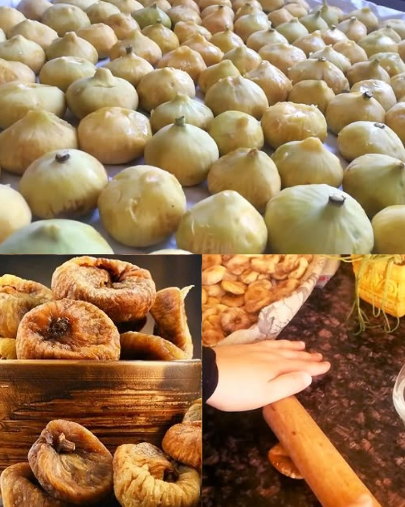
Turn Fresh Figs Into Nature’s Candy With These Easy Drying Methods
There’s something incredibly satisfying about a chewy, sweet dried fig. Whether you enjoy them in trail mix, baking, or just straight from the jar, dried figs are a powerhouse of flavor and nutrition. And the best part? You don’t need to rely on store-bought versions packed with preservatives. You can dry figs at home—easily, naturally, and with just a few tools.
Ready to turn your ripe figs into long-lasting snacks? Let’s get into the how, the why, and the easiest methods to get it done.
Why Dry Figs at Home?
Ever bitten into a dried fig and wondered how all that sweetness is packed into something so small? Drying removes moisture but leaves behind all the good stuff—fiber, antioxidants, vitamins, and minerals—in a more concentrated form.
Here’s why it’s worth doing at home:
- No chemicals or preservatives
- Full control over ripeness and quality
- Lower cost in the long run
- Fun and surprisingly easy
Plus, homemade dried figs store well and are perfect for snacking, baking, or adding to your favorite cheese board.
Method 1: Sun-Drying Figs the Traditional Way
If you’ve got good weather, sun drying is the most natural—and nostalgic—way to go.
Steps:
- Pick ripe figs – They should be soft but not mushy. Overripe figs won’t dry well and may ferment.
- Wash and dry – Rinse under cool water and pat them completely dry.
- Slice or leave whole – Cutting them in half speeds things up, but leaving them whole gives you a chewier texture.
- Lay them out – Place them on a clean tray or wire rack. Make sure they’re not touching to ensure airflow.
- Find a sunny spot – A patio or rooftop works well. Cover them with a mesh net to keep bugs and dust out.
- Flip daily – Turn them each day so they dry evenly on all sides.
- Check for doneness – After 3–5 days, the figs should feel leathery and slightly sticky—not wet or squishy.
Video : Figs are being dried | Fresh fig fruit being dried |
Tips for Success:
- Bring the figs indoors at night to avoid dew.
- Keep an eye on humidity—if it’s too high, they might mold instead of dry.
- If you live in a humid area, you might want to finish them in the oven.
Method 2: Oven-Drying for All-Weather Reliability
Don’t have endless sunshine? Your oven can do the job just fine—no sun required.
Steps:
- Preheat low and slow – Set your oven to around 120–140°F (50–60°C).
- Prepare the figs – Wash, dry, and slice them in half for better airflow.
- Line a baking tray – Use parchment paper and lay the figs cut-side up.
- Dry gradually – Place the tray in the oven. Keep the door slightly open to let moisture escape.
- Flip and rotate – Every few hours, flip the figs and rotate the tray for even drying.
- Wait it out – Drying usually takes 8–12 hours depending on fig size and moisture.
- Cool completely – Let them cool before transferring to containers. This prevents condensation (aka soggy figs).
Pro Tips:
- Use a fan or convection setting for better airflow.
- Check every hour after the 6-hour mark—there’s a fine line between chewy and crunchy.
- Want a little crispness? Leave them in a little longer.
Method 3: Using a Dehydrator for Hassle-Free Drying
This is the easiest, most hands-off method—perfect if you plan on drying figs often.
Steps:
- Wash and prep – Cut the figs in half or quarters depending on your texture preference.
- Load the trays – Arrange them on dehydrator trays with space between each piece.
- Set the temp – Ideal range is 130–140°F (55–60°C).
- Dry them down – Let them dehydrate for 8–12 hours.
- Cool before storing – Same rule as the other methods. No warmth when sealing them up.
Helpful Tips:
- Rotate trays if your dehydrator doesn’t have even airflow.
- The texture should be flexible, not crispy.
- Taste test toward the end—because why not?
How to Store Your Dried Figs Properly
Once your figs are dried and cooled, the real question is: how do you keep them fresh?
Here’s how:
- Airtight containers – Think glass jars, zip-lock bags, or vacuum-sealed pouches.
- Cool, dry, dark – Avoid sun exposure or humidity. Pantry shelves or kitchen drawers are ideal.
- Freeze for long term – For storage beyond 6 months, pop them in the freezer. They’ll stay fresh up to a year.
Also, label the jars with the drying date. Trust me, once you’re hooked, you’ll start drying in batches and need to keep track.
Bonus: Fun Ways to Use Dried Figs
You didn’t dry all these figs just to stare at them, right?
Here are some tasty ideas:
- Toss them in salads with goat cheese and arugula.
- Add to homemade granola or trail mix.
- Use in muffins, bread, or fig bars.
- Dip in dark chocolate for a fancy treat.
- Rehydrate in hot water for stews or sauces.
Seriously, dried figs are like nature’s candy, but better for you and without the guilt.
Video : How to Dry Figs: Double Your Fig Harvest by Dehydrating Figs
Conclusion: Dry Figs Your Way and Savor Them Year-Round
Drying figs at home might sound old-school, but it’s a game-changer. Whether you’re soaking up the sun, using your trusty oven, or letting a dehydrator do the work, the result is the same: a naturally sweet, fiber-packed snack that’s completely your own.
No additives. No chemicals. Just pure fruit goodness. So next time you spot a batch of ripe figs, don’t let them go to waste—turn them into a snack you’ll savor for months. Once you taste homemade dried figs, you’ll never want the store-bought kind again.
Go on—grab those figs and start drying!


